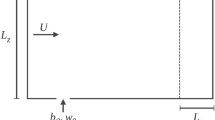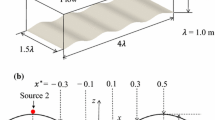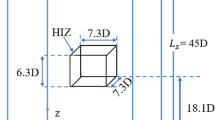Abstract
We consider large-eddy simulations (LES) of buoyant plumes from a circular source with initial buoyancy flux F 0 released into a stratified environment with constant buoyancy frequency N and a uniform crossflow with velocity U. We make a systematic comparison of the LES results with the mathematical theory of plumes in a crossflow. We pay particular attention to the limits \({\tilde{U}\ll1}\) and \({\tilde{U}\gg 1}\), where \({\tilde{U}=U/(F_0 N)^{1/4}}\), for which analytical results are possible. For \({\tilde{U}\gg 1}\), the LES results show good agreement with the well-known two-thirds law for the rise in height of the plume. Sufficiently far above the source, the centreline vertical velocity of the LES plumes is consistent with the analytical z −1/3 and z −1/2 scalings for respectively \({\tilde{U}\ll 1}\) and \({\tilde{U}\gg 1}\). In the general case, where the entrainment is assumed to be the sum of the contributions from the horizontal and vertical velocity components, we find that the discrepancy between the LES data and numerical solutions of the plume equations is largest for \({\tilde{U}=O(1)}\). We propose a modified additive entrainment assumption in which the contributions from the horizontal and vertical velocity components are not equally weighted. We test this against observations of the plume generated by the Buncefield fire in the U.K. in December 2005 and find that the results compare favourably. We also show that the oscillations of the plume as it settles down to its final rise height may be attenuated by the radiation of gravity waves. For \({\tilde{U}\ll 1}\) the oscillations decay rapidly due to the transport of energy away from the plume by gravity waves. For \({\tilde{U}>rsim 1}\) the gravity waves travel in the same direction and at the same speed as the flow. In this case, the oscillations of the plume do not decay greatly by radiation of gravity waves.
Similar content being viewed by others
References
Baines PG (1995) Topographic effects in stratified flows. Cambridge University Press, UK, 482 pp
Briggs GA (1984) Plume rise and buoyancy effects. In: Randerson D (eds) Atmospheric science and power production, Office of research. US Department of Energy, Washington, pp 327–366
Devenish BJ, Edwards JM (2009) Large-eddy simulation of the plume generated by the fire at the Buncefield oil depot in December 2005. Proc Roy Soc A 465: 397–419
Devenish BJ, Rooney GG, Thomson DJ (2010) Large-eddy simulation of a buoyant plume in uniform and stably stratified environments. J Fluid Mech (in press)
Fan LN (1967) Turbulent buoyant jets into stratified or flowing ambient fluids. Report KH-R-15, WM Keck Laboratory, Cal Tech, Pasadena
Fay JA, Escudier M, Hoult DP (1969) A correlation of field observations of plume rise. Publication No 69-4, Fluid Mechanics Laboratory, Massachusetts Institute of Technology
Gaskin SJ, Wood IR (1999) An experimental investigation of the entrainment into a buoyant jet in a weak crossflow. In: Davies PA (eds) Mixing and dispersion in stably stratified flows. Oxford University Press, UK, pp 323–340
Hoult DP, Fay JA, Forney LJ (1969) A theory of plume rise compared with field observations. J Air Pollut Control Assoc 19: 585–590
Hoult DP, Weil JC (1972) Turbulent plume in a laminar cross flow. Atmos Environ 6: 513–531
Hunt GR, Kaye NG (2001) Virtual origin correction for lazy turbulent plumes. J Fluid Mech 435: 377–396
Huq P, Stewart EJ (1996) A laboratory study of buoyant plumes in laminar and turbulent crossflows. Atmos Environ 30: 1125–1135
Lee JHW, Chu VH (2003) Turbulent jets and plumes—a Lagrangian approach. Kluwer Academic Publishers, Dordrecht, p 408 pp
Leonard BP, Lock AP, MacVean MK (1996) Conservative explicit unrestricted-time-step multidimensional constancy-preserving advection schemes. Mon Weather Rev 124: 2588–2606
List EJ (1982) Turbulent jets and plumes. Annu Rev Fluid Mech 14: 189–212
Mason P (1989) Large-eddy simulation of the convective atmospheric boundary layer. J Atmos Sci 46: 1492–1516
Middleton JH (1986) The rise of forced plumes in a stably stratified crossflow. Boundary-Layer Meteorol 36: 187–199
Morton BR (1959) Forced plumes. J Fluid Mech 5: 151–163
Morton BR, Taylor G, Turner JS (1956) Turbulent gravitational convection from maintained and instantaneous sources. Proc Roy Soc A 234: 1–23
Piacsek SA, Williams GP (1970) Conservation properties of convection difference schemes. J Comput Phys 6: 392–405
Robins AG, Contini D (2000) Water tank studies of the interactions between buoyant plumes emitted into a crossflow. In: Longhurst JWS, Brebbia CA, Power H (eds) Air pollution VIII. WIT Press, Southampton, pp 613–622
Spanier J, Oldham KB (1987) An atlas of functions. Hemisphere, New York, 700 pp
Turner JS (1973) Buoyancy effects in fluids. Cambridge University Press, UK, 367 pp
Webster HN, Abel SJ, Taylor JP, Thomson DJ, Haywood JM, Hort MC (2006) Dispersion modelling studies of the Buncefield oil depot incident. Hadley Centre Technical Note 69 (available from the National Meteorological Library)
Webster HN, Devenish BJ, Haywood JM, Lock AP, Thomson DJ (2010) Using plume rise schemes to model highly buoyant plumes from large fires. Int J Environ Pollut (in press)
Webster HN, Thomson DJ (2002) Validation of a Lagrangian model plume rise scheme using the Kincaid data set. Atmos Environ 36: 5051–5062
Weil JC (1988) Plume rise. In: Venkatram A, Wyngaard JC (eds) Lectures on air pollution modelling. American Meteorological Society, Boston, pp 119–166
Author information
Authors and Affiliations
Corresponding author
Rights and permissions
About this article
Cite this article
Devenish, B.J., Rooney, G.G., Webster, H.N. et al. The Entrainment Rate for Buoyant Plumes in a Crossflow. Boundary-Layer Meteorol 134, 411–439 (2010). https://doi.org/10.1007/s10546-009-9464-5
Received:
Accepted:
Published:
Issue Date:
DOI: https://doi.org/10.1007/s10546-009-9464-5




